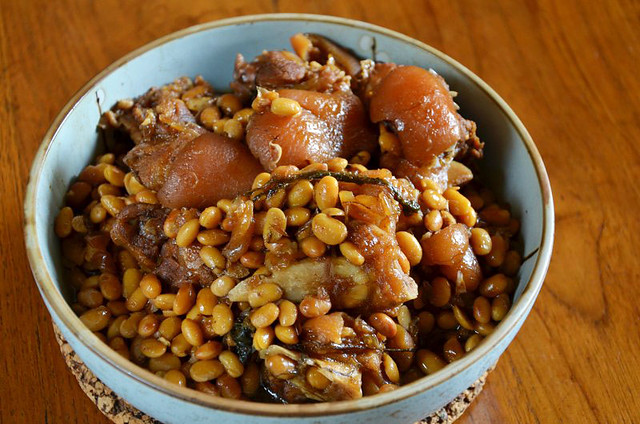
Pork leg with soy beans stew--so so yummy.
My MIL's Shanghainese pork leg and soy beans stew is a dish we look forward to find on her dining table when we eat dinner at her house on Saturdays but after tonight, MIL's pork leg stew looks like it might loose its crown to the stew cooked by my son Wey. To add insult to injury, it was the first time Wey had ever cooked the dish, and first time he ever handled a pork leg, which disgusted him a bit.
This is a great dish for one-pot dinners when you are too lazy to cook a banquet. Just add a soup and stir-fried veggies and nobody should complain. I don't cook pork leg often but once in a six-month while I do, especially when I see my face getting drawn and thin. Pork leg has lots of collagen and gelatine so go easy on that expensive jar of SK II and eat pork leg instead. Wishful but you never know.
This recipe is adapted from an old Japanese cookbook and all the ingredients are the same as my MIL's except sake is used in place of Shaoxin wine and Wey added a bunch of scallions and a tablespoon of dark soy sauce. The stew was so good that I suggested that they take most of it to my in laws and have dinner there, which of course Hub gladly did so.If the skin and ligament are not stewed soft enough, the gravy or sauce will not have that slight stickiness which is desirable (the stickiness) and makes the dish tastier. If the skin and ligament are cooked too soft, there won't be a bite although my son Wey prefers them this way. The best texture is when there's still a slight bite in the skin and the ligaments come off without you having turn your face to one side andto use your finger! s to pul l them off. What I do is cook the pork to a stage where the skin is still a little bit springy, turn of the heat and let the sauce and flavor seeps into the meat and then after an hour or so, timed about half hour before dinner is served, re-heat the stew.

Japanese Pork Leg With Soy Beans
1 medium-sized pork leg, about 1.7 kg bones on
350 gm dried soy beans, washed well & drained
6 T light soy sauce (I used Lee Kum Kee's)
1 T dark soy sauce
3 T sake
2 T veg oil
2 large stalks of spring onions or leeks, washed & tied in a bunch each
1 knob of fresh ginger (about 20 gm), washed n smashed lightly
1. Have the butcher clean, shave and cut the pork leg into large fist-sized pieces. Put the pork leg into a bowl and scald with enough boiling water to cover. Stir, then drain the water away. This step will clean the leg of any dirt or hairs and also gives a clearer gravy instead of a cloudy gravy later.
2. Marinade the pork leg with 3 tablespoons of the light soy sauce and the sake for about 1/2 hour.
3. Heat a heavy-based pot (such as AMC's) until smoking and throw in the ginger and spring onions. Fry until the onions are wilted. Add the pork leg (keep the marinade liquid) and stir fry until the skin is tightened and seared.
4. Add the soy beans to the pork leg, stir to mix well. Add the remaining 3 tablespoons of light soy sauce and dark soy sauce and enough water to just cover the pork leg and soy beans. When the stew boils, turn the heat down to low and simmer, covered, for 1 1/2 to 2 hours, depending on how you like the texture of the skin and ligament. There's no need to add anymore water but if you are cooking longer than 1 1/2 hours, you may have to add 1/2 cup of water. Taste and season with more soy sa! uce if n ecessary. Serve hot with rice. This dish gets better the next day.
No comments:
Post a Comment